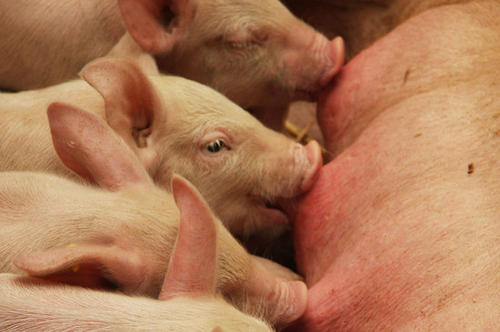Healthy Food for Animals and People
Zentek, a professor of animal nutrition at the Department of Veterinary Medicine of Freie Universität Berlin, studies ways to improve livestock feed.
May 26, 2011
Compound feed, premixed feed to meet all of an animal’s dietary needs, green fodder, concentrated feed, probiotics, plant-based substances, trace elements – the list of approved feeds and supplements is as widely varied as the different possible formulas. But what can and should end up in feed troughs? With his background in veterinary medicine, Zentek focuses on animal health in particular during his research into the best possible feeds.
“An optimum diet serves the animals’ welfare. And if cows, pigs, or poultry are healthy, the safety and quality of animal-based foods is also better,” Zentek says. But grass and grains for cows and chickens are no longer enough to get very far in industrial agriculture. Today’s high-performance animal feed is a precision-balanced mixture of carbohydrates, protein, minerals, trace elements, vitamins, and fat.
The basis for cattle feed is generally green fodder and processed or preserved forms of it, made from such crops as grass or corn, but also from other grains and legumes. Protein is often supplied by soybean meal, which is primarily imported from South or North America and therefore carries a certain level of risk of feed contamination. “Processing and long-distance transportation increase the risk of Salmonella contamination,” Zentek explains. “These kinds of problems can turn up in feed components even before they reach this country.” As a result, there is a need for better controls on imported raw materials, the veterinarian says.
The veterinary medicine experts at Freie Universität Berlin are currently studying the specific interactions of feed ingredients and the microorganisms present in the digestive tracts of pigs within an interdisciplinary collaborative research center funded by the German Research Foundation (DFG). Over 15 subprojects, the researchers involved are working with colleagues from Humboldt-Universität zu Berlin, the German Federal Institute for Risk Assessment (BfR), and other research institutions to study topics such as how to prevent pathogens from colonizing animals’ intestinal tracts and multiplying there. “The goal of our research is to raise animals without diseases to the greatest extent possible, thereby eliminating the need to give them medications,” Zentek says. This will ultimately also benefit consumers, since healthier animals in animal husbandry means safer food.
But enhancing the health of livestock alone does not guarantee food safety, a fact that has been brought home to wider audiences by scandals such as the one surrounding the finding of dioxin in animal feed at the start of this year. The toxic chemical was found based on an animal feed control system, coordinated by the German federal states, that applies to both farmers who mix their own feed and large-scale feed producers.
The system does have its weaknesses: While the “QS” quality seal promises quality and safety from the feed plant to the feedlot and beyond, right up to store shelves, there are no sanctions for violating the quality criteria, and those who violate the voluntary commitment to monitor their feeds are not subject to prosecution. All that unannounced inspectors can do in the field is take random samples from feed troughs and inspect livestock housing, animals, and the equipment used.
Most QS-certified feed manufacturers monitor their goods themselves. “The private and government controllers are not able to fully monitor all of the feeds used,” Zentek says. “In the worst case, if someone doesn’t play by the rules, undesired substances or contamination may go undiscovered for a long time.”
Further Information
- Prof. Dr. Jürgen Zentek, Department of Veterinary Medicine / Institute of Animal Nutrition,
Tel.: +49 (0)30 / 838-52256, Email: zentek.juergen@vetmed.fu-berlin.de

